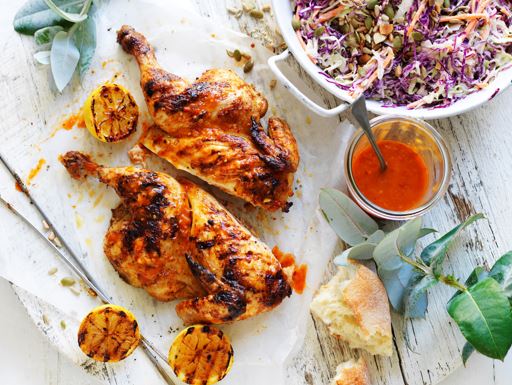Cooking with Sarah Boorer
Luke Grant is joined by Sarah Boorer, Nine Radio Journalist & Country Women’s Association award-winning cook, to look at the world of baked goods, delicious treats and & easy recipes.
This week Sarah looks cooking whole chicken…
Tips for slow cooking whole chicken:
- Slow cooking a whole chicken is so easy – either with a slow cooker or an oven proof dish with a lid.
- It’s always best to put some root vegetables as a layer on the bottom of the tray to keep the chicken off the base of the tray, to stop it overcooking.
- If you want the chicken to be ‘carvable’, cook for about 5-6 hours at approx 100 degrees C, or 7-8 hours if you want the meat falling off the bone. Always make sure the meat is cooked all the way through before taking it out of the oven/slow cooker.
- You don’t need to do much to prep the chicken, but a bit of oil or butter on (or tucked under) the skin definitely helps with the flavour. I like to make casseroles out of my roast chickens, so I cook for about 7 hours at low on a slow cooker (or 100 degree oven) and put the chicken on a bed of half cut, peeled, potatoes with 1L of stock, adding a bit of butter and seasoning rubbed into, and under, the skin.
- Flavour could be just about anything – garlic, lemon, onions, herbs, spices etc. You can put it into the cavity and rub it into the skin. Sometimes if I’m feeling lazy I’ll buy a casserole flavour packet from the shops and throw that in with the stock as the flavour which makes it a three step roast chicken (i.e. prepare the chicken and vegetables in the pot, pour over the stock and packet flavour and then cook).
- After I take out the chicken I add some (about 2 tablespoons) cornflour to the stock that’s left in the pan and turn it into a gravy. It usually requires a bit of simmering to get it thicker, if you like thick gravy.
- Basically, I start it in the morning when making the kids school lunches and then it’s ready in time for dinner.
Tips for roasting whole chicken:
- If you don’t want softer casserole-style chicken meat from your whole chicken, you can roast it in the oven to cook and get the skin crispy. Same seasoning principles apply as for slow cooking but don’t use the stock. You can marinate it for a few hours, or overnight, covered, in the fridge for best results.
- For crispy and tasty skin, pat the skin dry, drizzle with olive oil, and sprinkle salt, pepper and your choice of herb or seasoning.
- To BBQ the chicken, pre-heat to medium-high temperature, wrap up the chicken in aluminium foil and cook for at least an hour-1.5 hours with the hood down, until juices run clear and the chicken is thoroughly cooked, with the inside temperature having reached 75 degrees. It works best if you put a layer of root vegetables under the chicken before wrapping in aluminium foil and putting on the BBQ with the hood down.
- The bigger the chicken, the longer it will take to roast. Allow about 1.5 hours for a 2kg chicken.
- For roasting your chicken in the oven, use a higher temperature, say 180 – 210 degrees. For best results, cook at a higher temperature for about an hour and then cover and reduce the temperature to about 160 degrees C. Make sure you baste the skin with any juices in the pan halfway through otherwise the skin will burn.
- I usually put the roast chicken on the middle/upper shelves in the oven and put a water bath in another baking tray on the lower shelf. This keeps the air in the oven moist and helps keep your chicken moist.
- After I take out the chicken I add some (about a cup) stock and about 2 tablespoons cornflour to the burnt bits in the bottom of the pan and turn it into a gravy. Scrape the pan and mix it all together. This usually requires a bit of simmering to get it thicker, if you like thick gravy.
- After cooking, chop the whole chicken into pieces and serve people their favourite part. For information about the different cuts including their nutritional content, see ACMF’s website
Leftovers:
- If you don’t eat the whole chicken in one sitting, make stir fry, chicken salad, chicken rice paper rolls etc with leftovers. We usually make pizzas or pies with any leftovers, but they also go down a treat in sandwiches or wraps.
Download this podcast here















